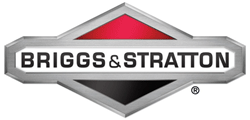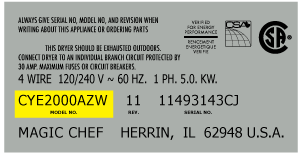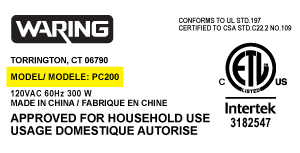11074410200 Kenmore Washer - Instructions
Keep searches simple. Use keywords, e.g. "leaking", "pump", "broken" or "fit".
Lid switch failed, dryer stopped working
Order replacement lid switch, installed it, good to go. The installation video and instructions with the replacement part were very helpful.
Parts Used:
-
Rick from BETHESDA, MD
-
Difficulty Level:Really Easy
-
Total Repair Time:30 - 60 mins
-
Tools:Nutdriver, Screw drivers, Socket set
1 of 2 people
found this instruction helpful.
Was this instruction helpful to you?
Thank you for voting!
washer continued to spin when you raised the lid not shutting off
Your web site is amazing Ive enjoyed watching your videos,this is a really great way to see what it takes to repair your washer very informative. Steve was a good teacher for me I just followed along as he explained each step and my washer came apart just like he said. I removed the two front console screws and pulled slightly forward and lifted console up and tilted it back where it was out of the way. next I was able to lift cabinet up from the back and remove it from the frame and lay cabinet on the floor on top of a rug I had to protect the finish on cabinet . Now I had access to the lid switch and simply removed the two screws in the cabinet and the old switch. I connected the two wire connections to the new switch (no)normally open connection, used same actuator the instructions say to do this because the one that comes with the new switch won't fit so use the old one. on my washer there's a cover that fits under this switch and It took me a little longer to get the screws to line up so they fit through the switch and into the cover but It worked fine. Now all I had to do was reinstall the cabinet just like Steve did on the video my only problem with this was seeing where the tabs in the frame were located so that the slots in the cabinet would fit over top of frame tabs I used a flash light in one hand and lowered the cabinet down I held the light on the frame tabs and the slots in cabinet fit right in then lowered cabinet to the rear frame tabs where i just had to push slightly on the sides of cabinet and it fit right in.Next i pushed the back panel in place and on the top of washer just like in video reinstalled both spring clip clamps and the console and reinstalled the two screws. I plugged in the washer put drain hose back in drain pushed washer back in place turned it on working great now ! Thank You so much for your help Dan.
Parts Used:
-
Daniel from TRENTON, NJ
-
Difficulty Level:Really Easy
-
Total Repair Time:30 - 60 mins
-
Tools:Screw drivers
1 of 2 people
found this instruction helpful.
Was this instruction helpful to you?
Thank you for voting!
Cold water input into the washing machine was very slow.
The hot water hose was frozen to the hot water bibb and it took me a while to cut it loose with my Dremel tool. Removed the cabinet and replaced the water inlet valve easily, then hooked up new hot and cold water hoses. Reinstalling the cabinet was a little tricky getting it lined up correctly. Checked for leaks then tested the washing machine and it ran great with the water filling the machine much faster with the new Water Inlet Valve. I will definitely replace the washing machine hot and cold water hoses every 5 years from now on.
Parts Used:
-
James R from Birmingham, AL
-
Difficulty Level:Difficult
-
Total Repair Time:More than 2 hours
-
Tools:Nutdriver, Pliers, Screw drivers, Wrench (Adjustable)
1 of 2 people
found this instruction helpful.
Was this instruction helpful to you?
Thank you for voting!
orginal water inlet failed due to age, easy fix !
Removed top control panel, removed inlet mount hardware, removed both electrical connectors, removed filler hose, Installed new inlet valve in reverse order. Works fine !
Parts Used:
-
Kenneth from RIVER EDGE, NJ
-
Difficulty Level:Very Easy
-
Total Repair Time:15 - 30 mins
-
Tools:Nutdriver, Pliers, Screw drivers
1 of 2 people
found this instruction helpful.
Was this instruction helpful to you?
Thank you for voting!
No hot water and limited cold water during wash and rinse cycle
I followed the video instructions to the tee. Took more time to move the machine out and put back than to replace the inlet valve.
Parts Used:
-
Les from GARNETT, KS
-
Difficulty Level:Really Easy
-
Total Repair Time:15 - 30 mins
-
Tools:Nutdriver, Pliers
1 of 2 people
found this instruction helpful.
Was this instruction helpful to you?
Thank you for voting!
Cold water was trickling into wash tub
Your video was helpful. I just followed the directions, replaced the valve, put it back together and celebrated spending $28 instead of the $100 deductible on my home warranty. If you're sure of the part you need, just do it.
Parts Used:
-
Brian from McKinney, TX
-
Difficulty Level:Easy
-
Total Repair Time:15 - 30 mins
-
Tools:Pliers, Screw drivers
1 of 2 people
found this instruction helpful.
Was this instruction helpful to you?
Thank you for voting!
washer would fill with water but not start
took part top of washer saw switch replaced it not to difficult it is always easier when you have new one to look at
Parts Used:
-
Edward from Nanuet, NY
-
Difficulty Level:A Bit Difficult
-
Total Repair Time:15 - 30 mins
-
Tools:Nutdriver, Screw drivers
5 of 15 people
found this instruction helpful.
Was this instruction helpful to you?
Thank you for voting!
The water inlet valve was defective
First I turned off the water to the washer and then removed the hot/cold water hoses going to the washer, unscrewed the water hoses from the washer, and cleaned the wire screens located immediately inside the inlet water valve. This did not solve the problem. Second, I loosened the hex head screws on the back panel of the washer. This allowed me access to the valve. I tested the valve solenoids with my ohm/volt meter and all checked out OK (but this did not make sense). Third, I surfed the web to find out if the symtoms of the washer's problem were the same as experienced by other people. I found several reports of the same symptoms, all which were solved by replacing the water inlet valve. This conformed my original diagnosis although the valve tested as OK. Fourth, I ordered the part from PartSelect, and removed the hose clamp and two mounting screws holding the old valve to the back panel of the washer and removed the old valves. Last, when the new valve arrived, I assembled the new backing plate to the new valve, attached it to the washer's back panel, attached the water hoses to the valve after fitting new rubber seals to the inside of the hoses, and reattached the washer back panel. The washer is working perfectly again.
Parts Used:
-
Kent from San Diego, CA
-
Difficulty Level:Easy
-
Total Repair Time:30 - 60 mins
-
Tools:Pliers, Screw drivers, Socket set
1 of 3 people
found this instruction helpful.
Was this instruction helpful to you?
Thank you for voting!
Refill valve leaked continuosly.
Removed the hoses from the inlet valve. Removed screws that hold control panel in place . Removed control panel which exposed two clips that hold the top of the back panel. Removed the ground screw freeing the ground wire, removed the plastic loom which holds a bundle of wires. I next removed the plastic plate that protects the fill valve from splashed water. Removed the screw that holds the valve in place, then removed the wires and the fill hose. Reversed steps to put back together.
Parts Used:
-
Kenneth from Adrian, OR
-
Difficulty Level:A Bit Difficult
-
Total Repair Time:1- 2 hours
-
Tools:Pliers, Socket set
1 of 3 people
found this instruction helpful.
Was this instruction helpful to you?
Thank you for voting!
Only hot water would be dispensed into the washing machine
took off the rear panel and removed the existing inlet valve and installed the new one. Replaced the rear panel and the machine work better than ever.
Parts Used:
-
Joselin from Port Saint Lucie, FL
-
Difficulty Level:Easy
-
Total Repair Time:15 - 30 mins
-
Tools:Pliers, Screw drivers, Socket set
1 of 3 people
found this instruction helpful.
Was this instruction helpful to you?
Thank you for voting!
My washing machine overflowed and flooded the basement
First, I unplugged it and disconnected the water hoses (the water has been off to it for days). Then, I tried taking off the back of the washing machine. This didn't work, and I actually ended up googling instructions and found pretty detailed, illustrated instructions at Popular Mechanics.
You need to unscrew the front panel that contains all of the controls first, flip it up, and unhook it from the back of the washer (via an electronics clip and 2 metal clips). The outer cover can then be taken off. I recommend undoing the internal hose next -- I used adjustable pliers to squeeze the connecter and loosen the hose. Then, unscrew the water inlet valve and take it off.
Putting everything back together literally just means reversing the instructions.
My washing machine is on a raise service, and I still haven't gotten the outer frame completely back in place correctly, but it's not touching anything or creating any problems. It's really only to safeguard parts anyways, so no worries if it's not perfect -- at least it works now!
You need to unscrew the front panel that contains all of the controls first, flip it up, and unhook it from the back of the washer (via an electronics clip and 2 metal clips). The outer cover can then be taken off. I recommend undoing the internal hose next -- I used adjustable pliers to squeeze the connecter and loosen the hose. Then, unscrew the water inlet valve and take it off.
Putting everything back together literally just means reversing the instructions.
My washing machine is on a raise service, and I still haven't gotten the outer frame completely back in place correctly, but it's not touching anything or creating any problems. It's really only to safeguard parts anyways, so no worries if it's not perfect -- at least it works now!
Parts Used:
-
Laura from Sterling, CT
-
Difficulty Level:A Bit Difficult
-
Total Repair Time:30 - 60 mins
-
Tools:Pliers, Screw drivers, Wrench (Adjustable)
1 of 3 people
found this instruction helpful.
Was this instruction helpful to you?
Thank you for voting!
squealing noise, very little cold water to fill tub, hot water normal
turn off hot and cold water faucets,unplug the power,pull washer out to gain access to rear cover, remove the top control panel screws,push back and lift off, disconnect hot and cold water hoses from inlet valve and remove enough screws from the back panel to remove the valve, disconnect the valve from the tub fill hose (mine had a spring type hose clamp) note the orientataion of the hot and cold hoses and the solenoid connectors for the hot and cold sides,(mine is stamped in the rear cover)reconnect and reassemble in reverse order and check for proper operation.
Parts Used:
-
richard from cleburne, TX
-
Difficulty Level:Easy
-
Total Repair Time:15 - 30 mins
-
Tools:Nutdriver, Pliers, Screw drivers
1 of 3 people
found this instruction helpful.
Was this instruction helpful to you?
Thank you for voting!
Water leakig into the tub after the cycle finished
First I unplugged the washing machine and turned off the inlet water faucets. I prepared my tools, spead a drop cloth, and had ready a towel and small bucket to catch water from the hoses.
I pulled the washer away from the wall and removed the screw holding the ground wire. I disconnected the inlet hoses and the drain hose from the wall and put the loose ends in the washer tub. Then I completly turned the washer around for easy access. I removed the inlet hoses and the drain hose using the bucket to catch the little water that was still in the hoses. I removed 2 screws holding the top control panel to the back place and removed the 3 screws at the bottom of the back plate. I also removed the two screws holding the control panel to the top of the washer. The water inlet valve is located on the left side looking at the rear about half way up. I was able to move the left panel of the washer out of the way an inch or so, and pull the left side of the rear panel away a few inches so I could stick my hand in and unhook the cold and hot wire cables. I memorized which went into which slot. Then I unscrewed the water inlet valve and pulled it out the opening to the back and using a pair of pliers I loosed the water clamp and removed the rubber inlet hose. A small amount of water came out which I was able to catch in my small pail.
The water inlet valve comes with a separate mounting plate. I attached the mounting plate with one of the screws provided. The screws are identical except one has a flat slot and the other has a special star slot.
I reattached the rubber inlet hose using the pliers to hold the clamp then positioned the water inlet valve back in place on the back panel. I put a screw in to hold it and reattached the wires for the hot and cold control. Then I tightened the screws.
I repositioned the panels and put the lower screws holding the back panel to the washer back in loosely. I positioned the control panel back on the top of the washer and reattached the two screws on the back and then the two screws holding the front of the control panel to the top of the washer. Then I reattached the inlet hoses and draine hose.
I used this opportunity with the washer away from the wall to clean the floor and wall behind it. After cleaning under the washer, I moved the dryer over and cleaned under the dryer and made sure the dryer hose was still connected.
I put the dryer back, and repositioined the washer half way back into the opening. The I reattached the ground wire to the back of the dryer and attached the hoses to the wall. Then I pushed the washer back into place. Using a level I rechecked the level of the washer. I turned the water back on and ran a small load of wash to test. It worked fine.
I pulled the washer away from the wall and removed the screw holding the ground wire. I disconnected the inlet hoses and the drain hose from the wall and put the loose ends in the washer tub. Then I completly turned the washer around for easy access. I removed the inlet hoses and the drain hose using the bucket to catch the little water that was still in the hoses. I removed 2 screws holding the top control panel to the back place and removed the 3 screws at the bottom of the back plate. I also removed the two screws holding the control panel to the top of the washer. The water inlet valve is located on the left side looking at the rear about half way up. I was able to move the left panel of the washer out of the way an inch or so, and pull the left side of the rear panel away a few inches so I could stick my hand in and unhook the cold and hot wire cables. I memorized which went into which slot. Then I unscrewed the water inlet valve and pulled it out the opening to the back and using a pair of pliers I loosed the water clamp and removed the rubber inlet hose. A small amount of water came out which I was able to catch in my small pail.
The water inlet valve comes with a separate mounting plate. I attached the mounting plate with one of the screws provided. The screws are identical except one has a flat slot and the other has a special star slot.
I reattached the rubber inlet hose using the pliers to hold the clamp then positioned the water inlet valve back in place on the back panel. I put a screw in to hold it and reattached the wires for the hot and cold control. Then I tightened the screws.
I repositioned the panels and put the lower screws holding the back panel to the washer back in loosely. I positioned the control panel back on the top of the washer and reattached the two screws on the back and then the two screws holding the front of the control panel to the top of the washer. Then I reattached the inlet hoses and draine hose.
I used this opportunity with the washer away from the wall to clean the floor and wall behind it. After cleaning under the washer, I moved the dryer over and cleaned under the dryer and made sure the dryer hose was still connected.
I put the dryer back, and repositioined the washer half way back into the opening. The I reattached the ground wire to the back of the dryer and attached the hoses to the wall. Then I pushed the washer back into place. Using a level I rechecked the level of the washer. I turned the water back on and ran a small load of wash to test. It worked fine.
Parts Used:
-
Kenneth from Palm City, FL
-
Difficulty Level:A Bit Difficult
-
Total Repair Time:1- 2 hours
-
Tools:Pliers, Screw drivers
0 of 1 people
found this instruction helpful.
Was this instruction helpful to you?
Thank you for voting!
water inlet valve was cracked on back of washing machine
i removed all screws for back of washer and removed top washer controls. then removed the valves and replaced with new one. reinstalled back in reverse order.really easy job. you just have to pay attention how you took it apart and study how it works , thanks!
Parts Used:
-
Marco from Somerville, MA
-
Difficulty Level:Easy
-
Total Repair Time:15 - 30 mins
-
Tools:Nutdriver, Screw drivers
0 of 1 people
found this instruction helpful.
Was this instruction helpful to you?
Thank you for voting!
Cold water was leaking into tub constantly and hot water took forever to fill.
With the help of reading about other individuals and their problem, I was able to replace the water inlet valve in less than 30 minutes. Unscrewed two screws on top to reveal the flat springs. Popped the springs and released the back of the washer. Removed the old part and replaced with new. A lot easier than I thought.
Parts Used:
-
Judith from St. Louis, MO
-
Difficulty Level:Really Easy
-
Total Repair Time:15 - 30 mins
-
Tools:Nutdriver, Pliers, Screw drivers
0 of 1 people
found this instruction helpful.
Was this instruction helpful to you?
Thank you for voting!


























